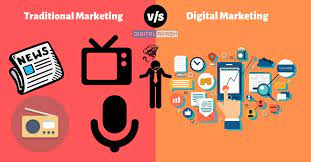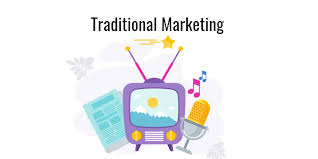
Traditional marketing vs Digital marketing:
Traditional marketing:

Traditional marketing refers to any type of marketing that existed before the advent of the internet and digital technologies. This includes various forms of advertising such as print ads, billboards, radio, and television commercials, as well as direct mail campaigns, telemarketing, and event sponsorships.
The primary aim of traditional marketing is to reach a large audience and create brand awareness through mass media. It typically involves a one-way communication approach where the marketer creates a message and delivers it to the audience, without expecting any immediate feedback.
Traditional marketing can be effective in reaching a broad audience and creating brand recognition, but it can also be expensive and difficult to measure its impact. With the rise of digital marketing, traditional marketing is becoming less prevalent, but it still plays a role in certain industries and for companies targeting specific demographics or geographic areas.
Advantage of Traditional Marketing:
While digital marketing has become increasingly popular in recent years, traditional marketing still has some advantages over its digital counterpart.
- Tangibility: Traditional marketing materials, such as flyers, brochures, and billboards, can be physically touched and held, which can make a stronger impression on potential customers.
- Local Targeting: Traditional marketing can be more effective at targeting a specific local market. For example, a billboard on a busy highway can reach a large number of people who drive by it every day.
- Familiarity: Traditional marketing has been around for a long time, and people are familiar with it. This can make traditional marketing more trustworthy to some people who may be skeptical of digital advertising.
- Branding: Traditional marketing can be effective for building brand awareness. Seeing a brand’s logo on billboards or hearing their jingle on the radio can help to establish a brand in people’s minds.
- Timelessness: Traditional marketing can have a longer lifespan than digital marketing. A magazine ad or a newspaper article can be saved and referred back to over time, while digital ads can disappear from people’s feeds quickly.
In summary, while digital marketing offers many advantages, traditional marketing can still be effective for certain businesses and industries. Tangibility, local targeting, familiarity, branding, and timelessness are just a few advantages of traditional marketing that should not be overlooked.
Disadvantage of Traditional Marketing:
Traditional marketing refers to the conventional methods of advertising that were prevalent before the advent of the internet and digital marketing. Some of the most common forms of traditional marketing include television and radio commercials, print advertisements, billboards, and direct mail.
One of the biggest disadvantages of traditional marketing is its limited reach. With traditional marketing, businesses are only able to target a limited audience, which can be both costly and ineffective. For example, a print advertisement in a local newspaper will only reach a small fraction of the population, and not all of those readers will be interested in the product or service being advertised.
Another disadvantage of traditional marketing is that it is difficult to measure its effectiveness. Unlike digital marketing, which allows businesses to track metrics such as website traffic, click-through rates, and conversion rates, traditional marketing methods do not provide such detailed data. This makes it challenging for businesses to assess the success of their marketing campaigns and make informed decisions about future strategies.
Finally, traditional marketing can be more expensive than digital marketing. Creating and distributing print advertisements, radio commercials, and television commercials can be costly, particularly for small businesses with limited budgets. This can limit their ability to effectively compete with larger companies that have more resources to allocate to marketing.
Digital Marketing:

Digital marketing is the practice of promoting products, services, or brands through digital channels, including websites, social media, search engines, email, mobile devices, and other online platforms. This form of marketing leverages technology to reach potential customers, engage with them, and convert them into loyal customers. Digital marketing includes a variety of strategies such as search engine optimization (SEO), pay-per-click (PPC) advertising, content marketing, email marketing, social media marketing, and mobile marketing. It enables businesses to reach a wider audience, track customer behavior and preferences, and measure the effectiveness of marketing campaigns in real-time. Digital marketing has become an essential component of modern marketing and is constantly evolving with new technologies and platforms. Its effectiveness depends on the ability to stay current with the latest trends and adapt to changing consumer behavior.
Advantages of Digital Marketing:
Digital marketing offers several advantages over traditional marketing methods. Here are some of the key advantages of digital marketing:
- Cost-effective: Digital marketing is usually more cost-effective than traditional marketing methods. Advertising on social media, email marketing, and search engine optimization can all be done at a lower cost than traditional advertising methods like TV, radio, or print.
- Targeted audience: With digital marketing, you can target your audience more effectively. Social media platforms and search engines allow you to target your ads based on demographics, interests, behaviors, and location.
- Measurable results: Digital marketing campaigns can be easily tracked and measured, providing you with valuable insights into the performance of your campaigns. You can measure the number of clicks, conversions, impressions, and other metrics to see how well your campaigns are performing.
- Increased brand awareness: With digital marketing, you can reach a wider audience and increase brand awareness. Social media platforms, search engines, and email marketing allow you to reach a large audience and engage with them on a personal level.
- Better customer engagement: Digital marketing allows you to engage with your customers in real-time. Social media platforms, email marketing, and chatbots enable you to interact with your customers and provide them with personalized support.
Overall, digital marketing offers several advantages over traditional marketing methods. It is cost-effective, targeted, measurable, and provides better customer engagement and increased brand awareness.
Disadvantages of Digital Marketing:
Despite its numerous advantages, digital marketing also has its own set of disadvantages. Here are some of them:
- High competition: As digital marketing is easily accessible to everyone, it results in high competition. Every business is trying to reach the same audience, which makes it difficult for small businesses to stand out.
- Dependence on technology: Digital marketing relies heavily on technology, and any technical malfunction or disruption can cause a significant setback to a business’s marketing strategy.
- Privacy concerns: The collection and use of personal data for digital marketing purposes have raised privacy concerns among consumers, leading to stricter regulations and increased scrutiny.
- Difficulty in measuring ROI: Measuring the return on investment (ROI) of digital marketing campaigns can be challenging, especially for businesses with complex sales funnels.
- Rapidly changing landscape: Digital marketing techniques and tools are constantly evolving, and keeping up with the latest trends and strategies can be time-consuming and costly.
- Ad fatigue: Overexposure to digital advertisements can lead to ad fatigue, where consumers become desensitized to the ads, resulting in reduced effectiveness of the marketing campaign.
Overall, while digital marketing offers many benefits, it also presents challenges that businesses must navigate to succeed in today’s competitive marketplace.
Traditional marketing vs Digital marketing:

Traditional marketing and digital marketing are two distinct approaches to promoting a product or service.
Traditional marketing involves advertising through various traditional media such as print ads, billboards, TV commercials, and radio ads.
Digital marketing, on the other hand, utilizes digital channels such as social media, email, search engines, and mobile applications to reach consumers.
Both traditional and digital marketing have their own strengths and weaknesses, and the best approach depends on various factors such as the target audience, the product or service being marketed, and the budget allocated for marketing.
Traditional marketing is typically more effective for reaching local audiences and older demographics who may not be as tech-savvy or as active on digital platforms. Traditional marketing methods can also help build brand awareness and establish trust in the marketplace.
Digital marketing, on the other hand, is often more cost-effective and provides a greater degree of flexibility and targeting options. Digital marketing allows businesses to reach a global audience and to track and measure the success of their marketing campaigns in real-time.
Overall, the best approach to marketing depends on the specific needs and goals of the business. Many successful marketing campaigns use a combination of both traditional and digital marketing methods to achieve the best possible results.
In conclusion, while both digital marketing and traditional marketing have their strengths and weaknesses, it is clear that digital marketing offers many advantages over traditional marketing. Digital marketing is more cost-effective, more targeted, more measurable, more flexible, and allows for more interactivity and global reach. For these reasons, many businesses are shifting their marketing strategies to focus more on digital channels.
